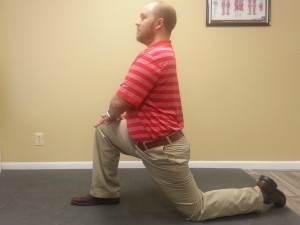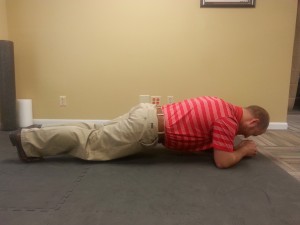Studies show that 8 out of 10 people will experience lower back pain in their lifetime. In fact, that is a common reason why people see a chiropractor, followed shortly with neck pain and headaches/migraines. A common question that we get asked in the office is “Why do I have low back pain and why does it keep coming back?” Well, there are many different reasons why someone experiences low back pain. One of the causes of low back pain that we see often is what we call- Lower Cross Syndrome.
What is Lower Cross Syndrome?
It is a muscular imbalance that results in postural changes which can cause lower back pain over time. The common changes that are seen are:
- Increased Lumbar Lordosis( low back curve)
- Protruding abdomen
- Anterior pelvic tilt (flexed hips)
- A flattened backside
What Causes it?

Lower cross syndrome can develop by sitting too long in the wrong position or by injury to the hips, pelvis or lower back. Prolonged sitting or injury can lead to development of shortened iliopsoas and hip flexor muscles and that leads to tightened lower back muscles. The tightened hip flexors eventually lead to weakened abdominal and core muscles along with weakened gluteal muscles.
This pairing of weakened core and buttock add to the anterior pelvic tilt and cause more stress on the lower back. This muscle imbalance leads to altered bio-mechanics and lower back pain. The lower back is essentially weaker and moving in an altered pattern which causes increased risk of injury and pain.
What can you do about it?
Well if you have lower back pain, you should see a medical professional and if you think you can some lower cross syndrome symptoms, a health professional can make a diagnosis and recommend the best treatment plan for your unique case. As a chiropractor, we can tell based on what your posture looks like and what we feel. We can also perform different functional tests to help figure out what is tight and what is weak. The most common known tests are Janda’s Movements.
To help treat the issue at hand, adjusting your body to make sure all the joints in the low back are moving properly and soft tissue work to correct the muscle tightness is important. Furthermore, exercises should be taught to correct the bad posture and help strengthen weak muscles while correcting muscle imbalances. Rocktape can also be used to help maintain the proper position throughout. Below are a few simple exercises and posture advice to help alleviate pain but you should talk with a health care professional before performing to determine if it is safe to perform the suggested exercises.
- Try not to sit for more than 30 minutes at a time; get up and walk around for about 1 minute to help stretch muscles and tight joints.
- When sitting in a chair, your knees should be lower than your hips and your feet should be touching the ground. Your knees should be at a 90 degree angle.
- Hip flexor Stretch: Kneel on your right knee stepping your left leg forward, in a lunge position.. Slowly lunge your body forward until you can feel the stretch in the front of your right hip. Take care not to allow our left knee to protrude. Hold for 30 seconds and then repeat the stretch on the other side.

- Plank: Position your body with your toe/or knees and elbows on the mat. Make sure your elbows are directly under your shoulders and your body is in a straight line. Brace your core muscles, and keep your head down. Hold this position for 15 seconds, gradually building up this time to 1 minute.
 Give us a call if you have any questions. Drs. Curtis and Kadi Fletcher of Fletcher Chiropractic are here to answer any questions you may have. They are located at 4300 S 48th St, Ste 7, Lincoln NE 68516.
Give us a call if you have any questions. Drs. Curtis and Kadi Fletcher of Fletcher Chiropractic are here to answer any questions you may have. They are located at 4300 S 48th St, Ste 7, Lincoln NE 68516.
